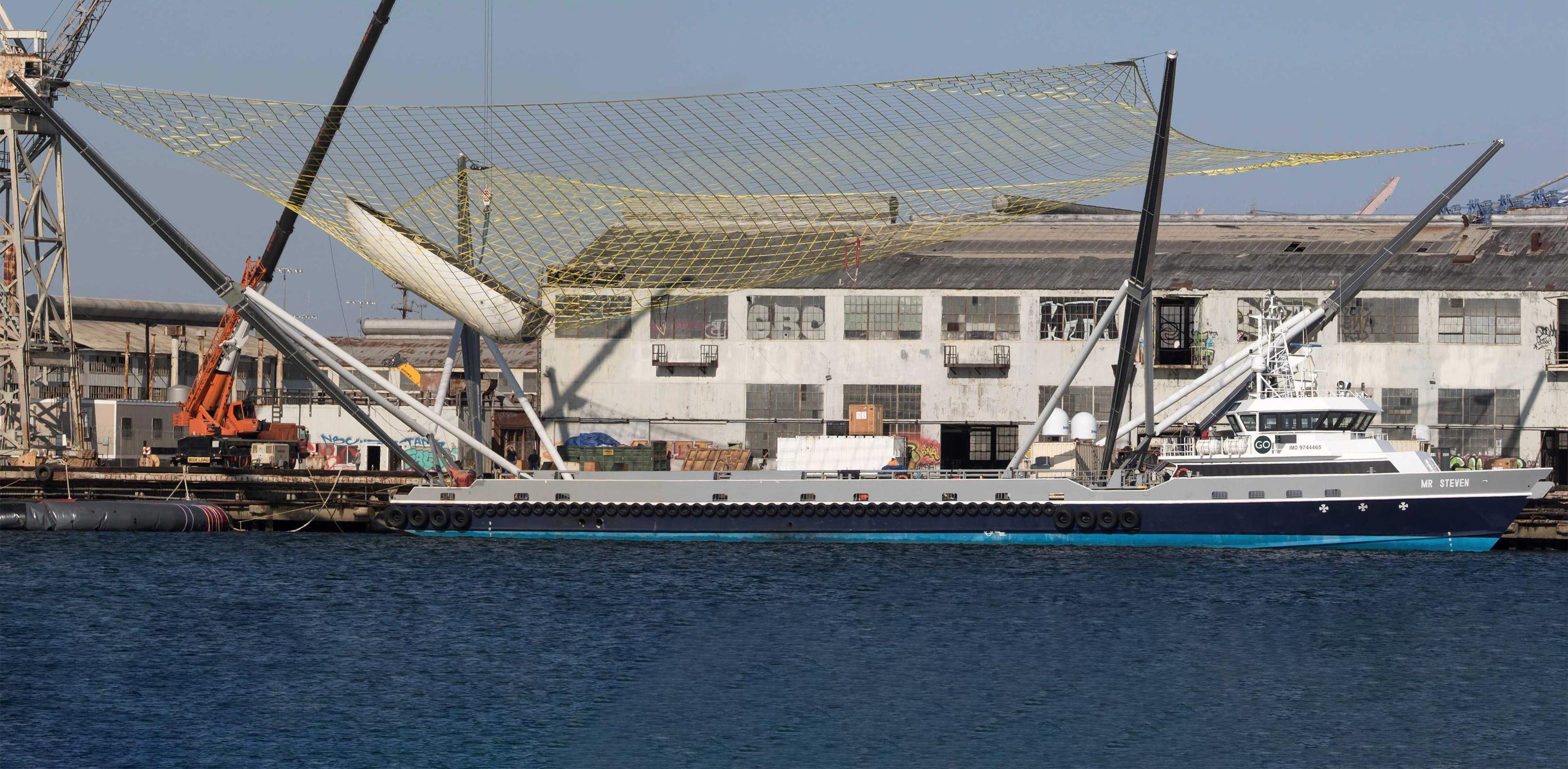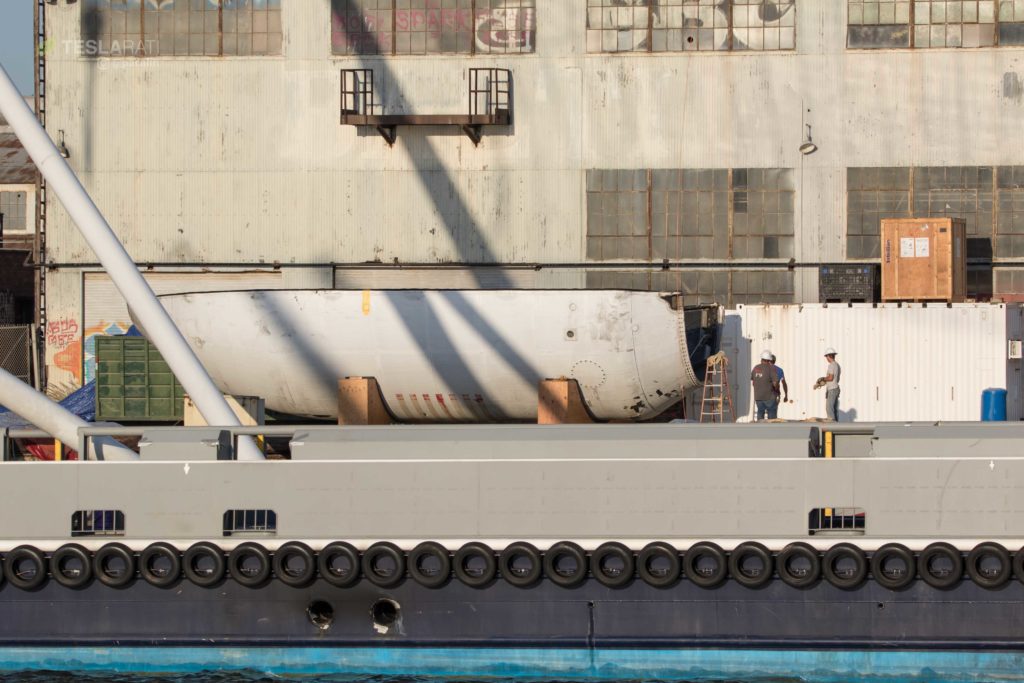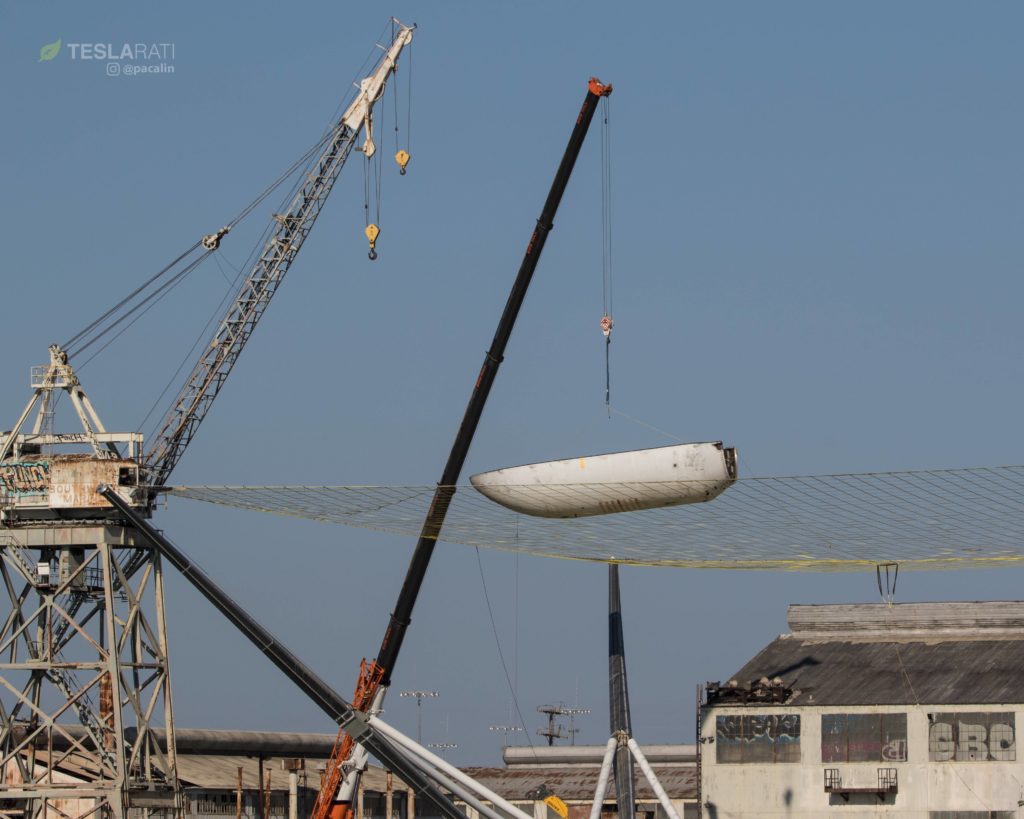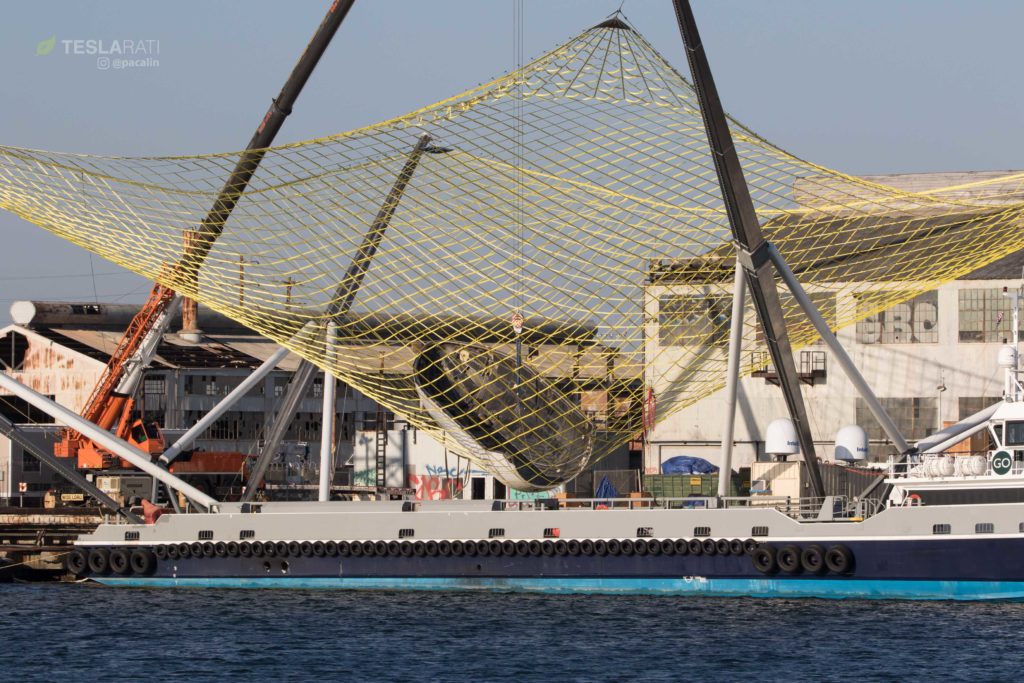

News
SpaceX’s Mr Steven spotted practicing Falcon 9 fairing catches with upgraded net
SpaceX’s fairing recovery vessel Mr Steven was spotted on Monday, August 13 conducting the first fairing recovery tests to involve actually craning a fairing half onto the huge, upgraded net, and doing so repeatedly in a short period of time. That practice will likely prove invaluable by allowing SpaceX to better understand the characteristics of Mr Steven’s fairing-catching net, rigging winches, and general operational behavior.
As SpaceX gradually approaches their next Falcon 9 launch from Vandenberg Air Force Base, the company is also preparing for Mr Steven’s next fairing recovery attempt, itself the second operational use of the vessel’s massively upgraded arms and net. Known as SAOCOM-1A, the Argentinian space agency’s Earth-imaging satellite is expected to launch no earlier than late September according to local South American media. Mr Steven’s late-July upgraded net debut was largely foiled by unpredictable winds in the region the fairing was parasailing, with that uncertainty preventing the fairing from getting close enough to its targeted landing position for Mr Steven to catch it out of the air.
It certainly appears that Mr Steven's net is capable of receiving a fairing half. Getting closer than ever. 8/13 #spaceX #mrsteven pic.twitter.com/Zqydum2FbB
— Pauline Acalin (@w00ki33) August 14, 2018
By all appearances, SpaceX is working hard to better understand how Mr Steven’s huge new net behaves when interacting with a Falcon fairing half, a reasonable goal in order to ensure that the first successful fairing catch is not foiled by something as simple as the half sliding down the net and cracking on Mr Steven’s deck. SpaceX’s fairings are incredibly fragile and are liable to irreparable crack at the slightest hint of off-nominal forces, meaning that all recovery efforts need to be extremely gentle if SpaceX ever hopes to recover and reuse those fairings halves multiples times, if at all.
- SpaceX technicians convene while testing Mr Steven’s net with a Falcon fairing half, 08/13/18. (Pauline Acalin)
- SpaceX used a crane to test Mr Steven’s net with a Falcon fairing half, 08/13/18. (Pauline Acalin)
- Mr Steven’s net spied testing off-center recovery operations with a Falcon fairing half, 08/13/18. (Pauline Acalin)
- Mr Steven’s net spied testing off-center recovery operations with a Falcon fairing half, 08/13/18. (Pauline Acalin)
- Mr Steven’s net spied testing off-center recovery operations with a Falcon fairing half, 08/13/18. (Pauline Acalin)
Still, even managing to reuse just one fairing half once for several launches (say, all California launches) would make a huge difference to the bottlenecked production line in SpaceX’s Hawthorne rocket and spacecraft factory, which is working around the clock to ramp up production of the upgraded Fairing 2.0 while also winding down the old Fairing 1.0 manufacturing apparatus. Intriguingly, it appears that SpaceX’s launch activity is likely to drop precipitously over the next several months, with no launches currently scheduled from the company’s two Florida pads in September or October – apparently due to a lack of payload availability rather than anything SpaceX-related.
Vandenberg will thus be the focus of SpaceX’s launch activities in September and October, hopefully supporting at least two missions. The first, SAOCOM-1A, is an Argentinian Earth observation satellite targeting a launch window in late September, reportedly delayed from September 5 to give SpaceX additional time to prepare Falcon 9. According to NASASpaceflight.com, SpaceX intends to refly Falcon 9 B1048 for this mission, giving the company just 6-8 weeks to refurbish the rocket and prepare it for the usual preflight static fire several days before launch. SAOCOM-1A will also likely mark the debut of SpaceX’s West Coast rocket landing zone, known as LZ-2.
Mr Steven lowering a fairing half into and out of the net today! Practice makes perfect.#spacex #mrsteven pic.twitter.com/oo4YAyWcuK
— Pauline Acalin (@w00ki33) August 14, 2018
While not yet solid, Iridium CEO Matt Desch acknowledged on August 13th that the company’s 8th and final SpaceX launch – Iridium NEXT-8 – would have its satellites ready no earlier than October, likely making it SpaceX’s subsequent payload after SAOCOM-1A. On the opposite coast, SpaceX’s next launch will be Telstar 18V – companion to 19V – on a new Falcon 9 Block 5 booster, currently scheduled for no earlier than 11:33 PM EDT, August 23. That Falcon 9 is already at Pad 40 preparing for a preflight static fire late this week or early next.
For prompt updates, on-the-ground perspectives, and unique glimpses of SpaceX’s rocket recovery fleet check out our brand new LaunchPad and LandingZone newsletters!
News
Tesla begins Robotaxi certification push in Arizona: report
Tesla seems serious about expanding its Robotaxi service to several states in the coming months.

Tesla has initiated discussions with Arizona transportation regulators to certify its driverless Robotaxi service in the state, as per a recent report from Bloomberg News. The move follows Tesla’s launch of its Robotaxi pilot program in Austin, Texas, as well as CEO Elon Musk’s recent comments about the service’s expansion in the Bay Area.
The Arizona Department of Transportation confirmed to Bloomberg that Tesla has reached out to begin the certification process for autonomous ride-sharing operations in the state. While details remain limited, the outreach suggests that Tesla is serious about expanding its driverless Robotaxi service to several territories in the coming months.
The Arizona development comes as Tesla prepares to expand its service area in Austin this weekend, as per CEO Elon Musk in a post on X. Musk also stated that Tesla is targeting the San Francisco Bay Area as its next major market, with a potential launch “in a month or two,” pending regulatory approvals.
Tesla first launched its autonomous ride-hailing program on June 22 in Austin with a small fleet of Model Y vehicles, accompanied by a Tesla employee in the passenger seat to monitor safety. While still classified as a test, Musk has said the program will expand to about 1,000 vehicles in the coming months. Tesla will later upgrade its Robotaxi fleet with the Cyercab, a two-seater that is designed without a steering wheel.
Sightings of Cybercab castings around the Giga Texas complex suggests that Tesla may be ramping the initial trial production of the self-driving two-seater. Tesla, for its part, has noted in the past that volume production of the Cybercab is expected to start sometime next year.
In California, Tesla has already applied for a transportation charter-party carrier permit from the state’s Public Utilities Commission. The company is reportedly taking a phased approach to operating in California, with the Robotaxi service starting with pre-arranged rides for employees in vehicles with safety drivers.
News
Tesla sets November 6 date for 2025 Annual Shareholder Meeting
The automaker announced the date on Thursday in a Form 8-K.

Tesla has scheduled its 2025 annual shareholder meeting for November 6, addressing investor concerns that the company was nearing a legal deadline to hold the event.
The automaker announced the date on Thursday in a Form 8-K submitted to the United States Securities and Exchange Commission (SEC). The company also listed a new proposal submission deadline of July 31 for items to be included in the proxy statement.
Tesla’s announcement followed calls from a group of 27 shareholders, including the leaders of large public pension funds, which urged Tesla’s board to formally set the meeting date, as noted in a report from The Wall Street Journal.
The group noted that under Texas law, where Tesla is now incorporated, companies must hold annual meetings within 13 months of the last one if requested by shareholders. Tesla’s previous annual shareholder meeting was held on June 13, 2024, which placed the July 13 deadline in focus.
Tesla originally stated in its 2024 annual report that it would file its proxy statement by the end of April. However, an amended filing on April 30 indicated that the Board of Directors had not yet finalized a meeting date, at least at the time.
The April filing also confirmed that Tesla’s board had formed a special committee to evaluate certain matters related to CEO Elon Musk’s compensation plan. Musk’s CEO performance award remains at the center of a lengthy legal dispute in Delaware, Tesla’s former state of incorporation.
Due to the aftermath of Musk’s legal dispute about his compensation plan in Delaware, he has not been paid for his work at Tesla for several years. Musk, for his part, has noted that he is more concerned about his voting stake in Tesla than his actual salary.
At last year’s annual meeting, TSLA shareholders voted to reapprove Elon Musk’s compensation plan and ratified Tesla’s decision to relocate its legal domicile from Delaware to Texas.
Elon Musk
Grok coming to Tesla vehicles next week “at the latest:” Elon Musk
Grok’s rollout to Tesla vehicles is expected to begin next week at the latest.

Elon Musk announced on Thursday that Grok, the large language model developed by his startup xAI, will soon be available in Tesla vehicles. Grok’s rollout to Tesla vehicles is expected to begin next week at the latest, further deepening the ties between the two Elon Musk-led companies.
Tesla–xAI synergy
Musk confirmed the news on X shortly after livestreaming the release of Grok 4, xAI’s latest large language model. “Grok is coming to Tesla vehicles very soon. Next week at the latest,” Musk wrote in a post on social media platform X.
During the livestream, Musk and several members of the xAI team highlighted several upgrades to Grok 4’s voice capabilities and performance metrics, positioning the LLM as competitive with top-tier models from OpenAI and Google.
The in-vehicle integration of Grok marks a new chapter in Tesla’s AI development. While Tesla has long relied on in-house systems for autonomous driving and energy optimization, Grok’s integration would introduce conversational AI directly into its vehicles’ user experience. This integration could potentially improve customer interaction inside Tesla vehicles.
xAI and Tesla’s collaborative footprint
Grok’s upcoming rollout to Tesla vehicles adds to a growing business relationship between Tesla and xAI. Earlier this year, Tesla disclosed that it generated $198.3 million in revenue from commercial, consulting, and support agreements with xAI, as noted in a report from Bloomberg News. A large portion of that amount, however, came from the sale of Megapack energy storage systems to the artificial intelligence startup.
In July 2023, Musk polled X users about whether Tesla should invest $5 billion in xAI. While no formal investment has been made so far, 68% of poll participants voted yes, and Musk has since stated that the idea would be discussed with Tesla’s board.
-

 Elon Musk1 week ago
Elon Musk1 week agoTesla investors will be shocked by Jim Cramer’s latest assessment
-

 Elon Musk3 days ago
Elon Musk3 days agoElon Musk confirms Grok 4 launch on July 9 with livestream event
-

 Elon Musk13 hours ago
Elon Musk13 hours agoxAI launches Grok 4 with new $300/month SuperGrok Heavy subscription
-

 News7 days ago
News7 days agoTesla Model 3 ranks as the safest new car in Europe for 2025, per Euro NCAP tests
-

 Elon Musk2 weeks ago
Elon Musk2 weeks agoA Tesla just delivered itself to a customer autonomously, Elon Musk confirms
-

 Elon Musk1 week ago
Elon Musk1 week agoxAI’s Memphis data center receives air permit despite community criticism
-

 Elon Musk2 weeks ago
Elon Musk2 weeks agoTesla’s Omead Afshar, known as Elon Musk’s right-hand man, leaves company: reports
-

 News2 weeks ago
News2 weeks agoXiaomi CEO congratulates Tesla on first FSD delivery: “We have to continue learning!”






















